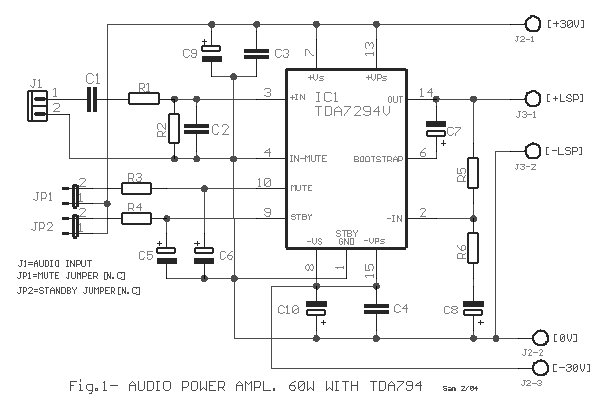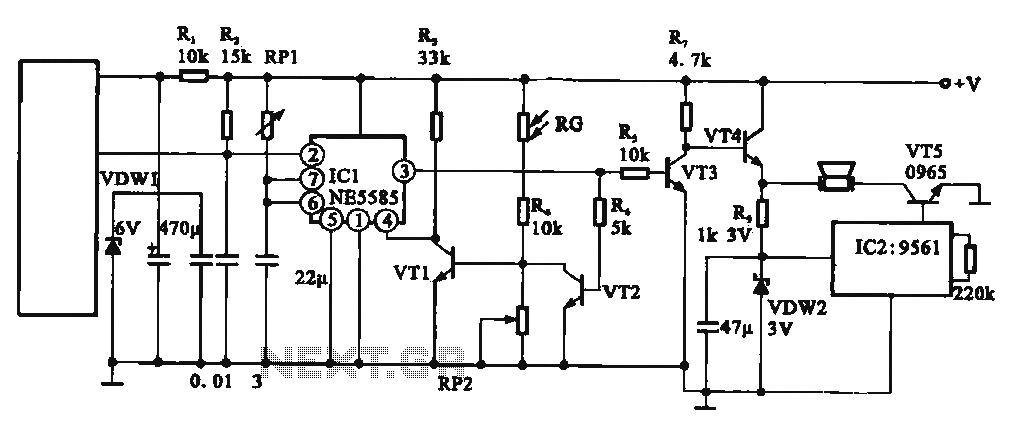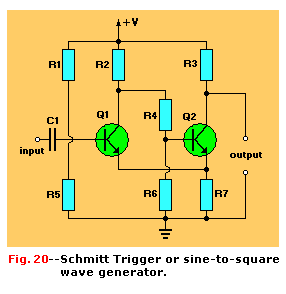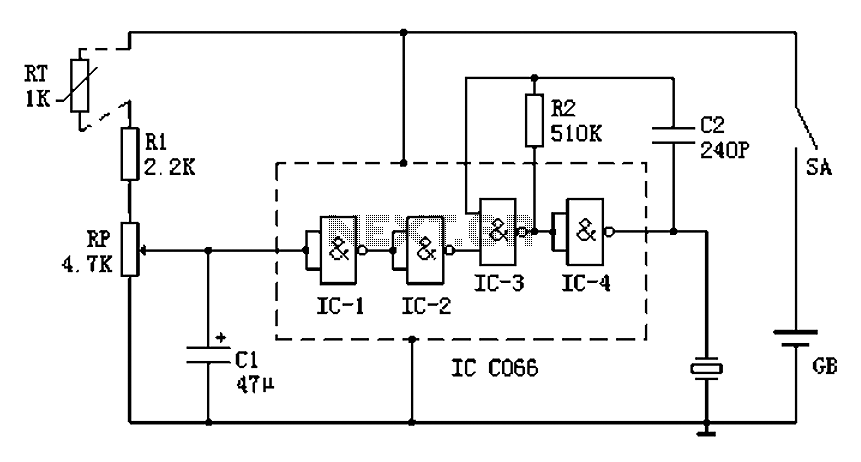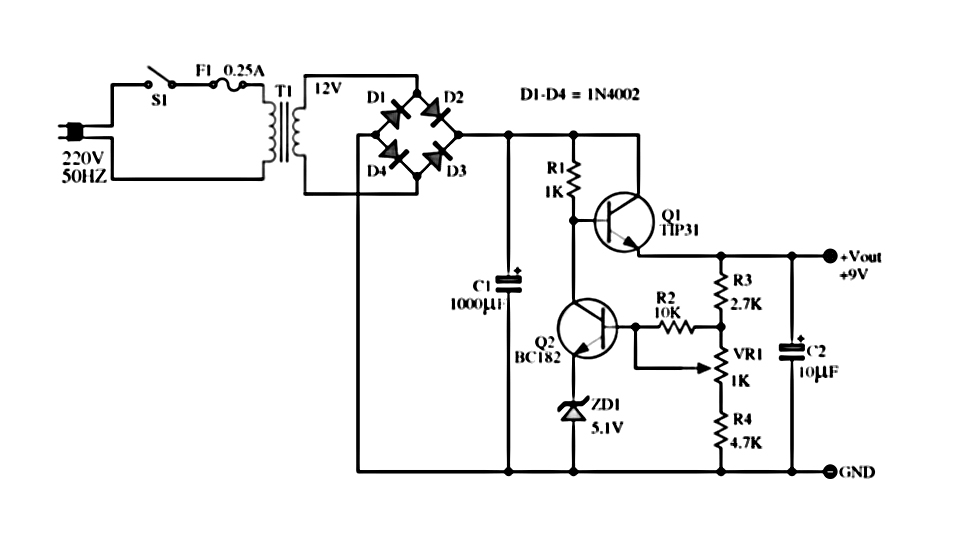
Shadow Alarm Circuit

This shadow alarm circuit can detect a moving shadow in a confined area, providing protection against theft. When an individual approaches the unit, it triggers a loud alarm to deter the theft attempt. The circuit leverages the light-sensing characteristics of a PIN photodiode. The p-n junction of the photodiode generates a light current when forward biased. The operational amplifier IC1 functions as a voltage comparator. Its non-inverting input connects to a potential divider formed by resistors R1 and VR. Adjusting VR allows for setting the input current to pin 3 at a reference level. The inverting input of IC1 is linked to the photodiode. IC CA3130 is a 15 MHz BiMOS operational amplifier featuring MOSFET inputs and bipolar outputs. The inputs utilize MOSFET transistors to achieve very high input impedance and minimal input current, as low as 10 pA. This amplifier is designed for high-speed performance and is suitable for low input current applications. Both CA3130A and CA3130 operational amplifiers combine the benefits of CMOS and bipolar transistors. The input circuit employs gate-protected P-Channel MOSFET (PMOS) transistors, ensuring very high input impedance, very low input current, and exceptional speed performance. The PMOS transistors in the input stage allow for a common-mode input voltage capability down to 0.5V below the negative-supply terminal, which is advantageous in single-supply applications. A CMOS transistor pair in the output circuit can swing the output voltage to within 10 mV of either supply voltage terminal, even at high load impedance values. The CA3130 Series operates at supply voltages ranging from 5V to 16V and can be phase compensated with a single external capacitor. It includes terminals for offset voltage adjustment for applications that require offset-null capabilities and provisions for strobing the output stage. The CA3130A provides superior input characteristics compared to the CA3130. Under normal lighting conditions (as set by VR), the photodiode supplies voltage to pin 2 of IC1. As this voltage exceeds the reference voltage set by VR at pin 3, the output of IC1 remains low, keeping the LED and buzzer inactive. However, when a person approaches the photodiode, the shadow reduces the current through it, causing the voltage at pin 2 to drop below that of pin 3. This results in the output of IC1 going high, activating the buzzer.
The shadow alarm circuit is designed for practical applications in security systems, specifically for theft deterrence in confined spaces. The PIN photodiode serves as the primary sensor, responding to changes in light levels due to the presence of a shadow. The operational amplifier IC1, configured as a voltage comparator, plays a crucial role in determining when the alarm should be triggered.
The potential divider formed by R1 and VR allows for fine-tuning the sensitivity of the circuit. By adjusting VR, the threshold at which the alarm activates can be customized to suit different environmental conditions and lighting scenarios. This flexibility makes the circuit adaptable for various applications, from home security to retail environments.
The CA3130 operational amplifier is particularly well-suited for this application due to its high input impedance and low bias current, which are essential for accurately detecting small changes in light levels without introducing significant noise or interference. The use of PMOS transistors in the input stage enhances the circuit's performance by providing a high degree of sensitivity while maintaining stability across a range of operating conditions.
Moreover, the circuit's design allows it to function effectively within a supply voltage range of 5V to 16V, making it compatible with common power sources. The ability to phase compensate the amplifier with a single capacitor simplifies the design process while ensuring reliable operation.
In summary, this shadow alarm circuit is an effective and efficient solution for detecting unauthorized access through shadow movement, combining advanced electronic components to achieve high performance and reliability in security applications.This shadow alarm circuit can sense a moving shadow in a confined area. It can be used to protect things from theft. When somebody approaches the unit, it will give a loud alarm to abort the attempt of theft. The circuit uses the light sensing property of the Photo diode. The circuit uses the light sensing property of the PIN Photodiode. The p-n j unction of the photo diode gives light current when it is forward biased. IC1 is designed as a voltage comparator. Its non inverting input is connected to a potential divider R1 and VR. By adjusting VR, input current to pin3 can be set to a reference level. The inverting input of IC1 is connected to a photo diode. IC CA3130 is a 15 MHz BiMOS Operational amplifier with MOSFET inputs and bipolar output. The inputs contain MOSFET transistors to provide very high input impedance and very low input current as low as 10pA. It has high speed of performance and suitable for low input current applications. CA3130A and CA3130 are op amps that combine the advantage of both CMOS and bipolar transistors. Gate-protected P-Channel MOSFET (PMOS) transistors are used in the input circuit to provide very-high-input impedance, very-low-input current and exceptional speed performance.
The use of PMOS transistors in the input stage results in common-mode input-voltage capability down to 0. 5V below the negative-supply terminal, an important attribute in single-supply applications. A CMOS transistor-pair, capable of swinging the output voltage to within 10mV of either supply-voltage terminal (at very high values of load impedance), is employed as the output circuit.
The CA3130 Series circuits operate at supply voltages ranging from 5V to 16V, They can be phase compensated with a single external capacitor, and have terminals for adjustment of offset voltage for application requiring offset-null capability. Terminal provisions are also made to permit strobing of the output stage. The CA3130A offers superior input characteristics over those of the CA3130. Normally in the light (as set by VR) Photodiode gives voltage to pin2 of IC1. Since this voltage is higher than the voltage set by VR at pin3, output of IC1 remains low keeping LED and buzzer off.
When a person approaches the photodiode, the shadow causes a reduction in current through the photodiode so that voltage at pin2 decreases below that of pin3. Output of IC1 then goes high and Buzzer sounds. 🔗 External reference
The shadow alarm circuit is designed for practical applications in security systems, specifically for theft deterrence in confined spaces. The PIN photodiode serves as the primary sensor, responding to changes in light levels due to the presence of a shadow. The operational amplifier IC1, configured as a voltage comparator, plays a crucial role in determining when the alarm should be triggered.
The potential divider formed by R1 and VR allows for fine-tuning the sensitivity of the circuit. By adjusting VR, the threshold at which the alarm activates can be customized to suit different environmental conditions and lighting scenarios. This flexibility makes the circuit adaptable for various applications, from home security to retail environments.
The CA3130 operational amplifier is particularly well-suited for this application due to its high input impedance and low bias current, which are essential for accurately detecting small changes in light levels without introducing significant noise or interference. The use of PMOS transistors in the input stage enhances the circuit's performance by providing a high degree of sensitivity while maintaining stability across a range of operating conditions.
Moreover, the circuit's design allows it to function effectively within a supply voltage range of 5V to 16V, making it compatible with common power sources. The ability to phase compensate the amplifier with a single capacitor simplifies the design process while ensuring reliable operation.
In summary, this shadow alarm circuit is an effective and efficient solution for detecting unauthorized access through shadow movement, combining advanced electronic components to achieve high performance and reliability in security applications.This shadow alarm circuit can sense a moving shadow in a confined area. It can be used to protect things from theft. When somebody approaches the unit, it will give a loud alarm to abort the attempt of theft. The circuit uses the light sensing property of the Photo diode. The circuit uses the light sensing property of the PIN Photodiode. The p-n j unction of the photo diode gives light current when it is forward biased. IC1 is designed as a voltage comparator. Its non inverting input is connected to a potential divider R1 and VR. By adjusting VR, input current to pin3 can be set to a reference level. The inverting input of IC1 is connected to a photo diode. IC CA3130 is a 15 MHz BiMOS Operational amplifier with MOSFET inputs and bipolar output. The inputs contain MOSFET transistors to provide very high input impedance and very low input current as low as 10pA. It has high speed of performance and suitable for low input current applications. CA3130A and CA3130 are op amps that combine the advantage of both CMOS and bipolar transistors. Gate-protected P-Channel MOSFET (PMOS) transistors are used in the input circuit to provide very-high-input impedance, very-low-input current and exceptional speed performance.
The use of PMOS transistors in the input stage results in common-mode input-voltage capability down to 0. 5V below the negative-supply terminal, an important attribute in single-supply applications. A CMOS transistor-pair, capable of swinging the output voltage to within 10mV of either supply-voltage terminal (at very high values of load impedance), is employed as the output circuit.
The CA3130 Series circuits operate at supply voltages ranging from 5V to 16V, They can be phase compensated with a single external capacitor, and have terminals for adjustment of offset voltage for application requiring offset-null capability. Terminal provisions are also made to permit strobing of the output stage. The CA3130A offers superior input characteristics over those of the CA3130. Normally in the light (as set by VR) Photodiode gives voltage to pin2 of IC1. Since this voltage is higher than the voltage set by VR at pin3, output of IC1 remains low keeping LED and buzzer off.
When a person approaches the photodiode, the shadow causes a reduction in current through the photodiode so that voltage at pin2 decreases below that of pin3. Output of IC1 then goes high and Buzzer sounds. 🔗 External reference
